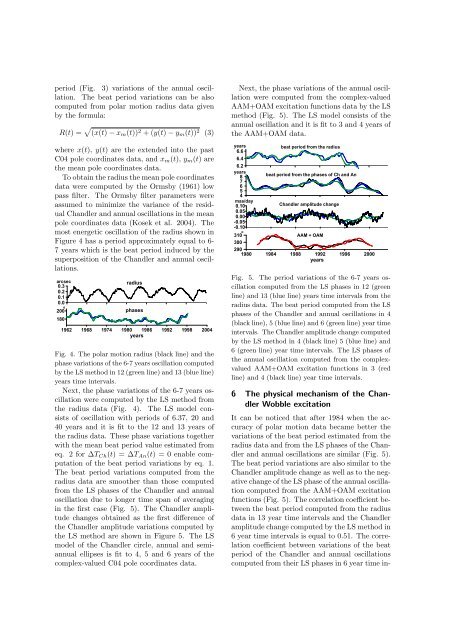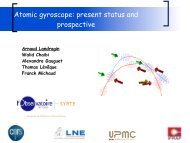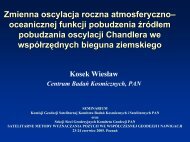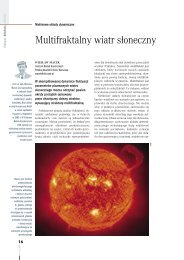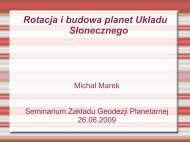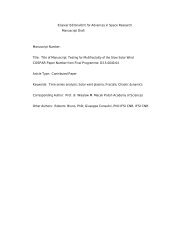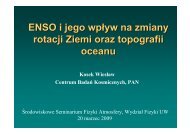Excitation of the Chandler wobble by the geophysical annual cycle
Excitation of the Chandler wobble by the geophysical annual cycle
Excitation of the Chandler wobble by the geophysical annual cycle
You also want an ePaper? Increase the reach of your titles
YUMPU automatically turns print PDFs into web optimized ePapers that Google loves.
period (Fig. 3) variations <strong>of</strong> <strong>the</strong> <strong>annual</strong> oscillation.<br />
The beat period variations can be also<br />
computed from polar motion radius data given<br />
<strong>by</strong> <strong>the</strong> formula:<br />
R(t) = √ (x(t) − x m (t)) 2 + (y(t) − y m (t)) 2 (3)<br />
where x(t), y(t) are <strong>the</strong> extended into <strong>the</strong> past<br />
C04 pole coordinates data, and x m (t), y m (t) are<br />
<strong>the</strong> mean pole coordinates data.<br />
To obtain <strong>the</strong> radius <strong>the</strong> mean pole coordinates<br />
data were computed <strong>by</strong> <strong>the</strong> Orms<strong>by</strong> (1961) low<br />
pass filter. The Orms<strong>by</strong> filter parameters were<br />
assumed to minimize <strong>the</strong> variance <strong>of</strong> <strong>the</strong> residual<br />
<strong>Chandler</strong> and <strong>annual</strong> oscillations in <strong>the</strong> mean<br />
pole coordinates data (Kosek et al. 2004). The<br />
most energetic oscillation <strong>of</strong> <strong>the</strong> radius shown in<br />
Figure 4 has a period approximately equal to 6-<br />
7 years which is <strong>the</strong> beat period induced <strong>by</strong> <strong>the</strong><br />
superposition <strong>of</strong> <strong>the</strong> <strong>Chandler</strong> and <strong>annual</strong> oscillations.<br />
arcsec<br />
radius<br />
0.3<br />
0.2<br />
0.1<br />
0.0<br />
o<br />
200 phases<br />
180<br />
1962 1968 1974 1980 1986 1992 1998 2004<br />
years<br />
Fig. 4. The polar motion radius (black line) and <strong>the</strong><br />
phase variations <strong>of</strong> <strong>the</strong> 6-7 years oscillation computed<br />
<strong>by</strong> <strong>the</strong> LS method in 12 (green line) and 13 (blue line)<br />
years time intervals.<br />
Next, <strong>the</strong> phase variations <strong>of</strong> <strong>the</strong> 6-7 years oscillation<br />
were computed <strong>by</strong> <strong>the</strong> LS method from<br />
<strong>the</strong> radius data (Fig. 4). The LS model consists<br />
<strong>of</strong> oscillation with periods <strong>of</strong> 6.37, 20 and<br />
40 years and it is fit to <strong>the</strong> 12 and 13 years <strong>of</strong><br />
<strong>the</strong> radius data. These phase variations toge<strong>the</strong>r<br />
with <strong>the</strong> mean beat period value estimated from<br />
eq. 2 for ∆T Ch (t) = ∆T An (t) = 0 enable computation<br />
<strong>of</strong> <strong>the</strong> beat period variations <strong>by</strong> eq. 1.<br />
The beat period variations computed from <strong>the</strong><br />
radius data are smoo<strong>the</strong>r than those computed<br />
from <strong>the</strong> LS phases <strong>of</strong> <strong>the</strong> <strong>Chandler</strong> and <strong>annual</strong><br />
oscillation due to longer time span <strong>of</strong> averaging<br />
in <strong>the</strong> first case (Fig. 5). The <strong>Chandler</strong> amplitude<br />
changes obtained as <strong>the</strong> first difference <strong>of</strong><br />
<strong>the</strong> <strong>Chandler</strong> amplitude variations computed <strong>by</strong><br />
<strong>the</strong> LS method are shown in Figure 5. The LS<br />
model <strong>of</strong> <strong>the</strong> <strong>Chandler</strong> circle, <strong>annual</strong> and semi<strong>annual</strong><br />
ellipses is fit to 4, 5 and 6 years <strong>of</strong> <strong>the</strong><br />
complex-valued C04 pole coordinates data.<br />
Next, <strong>the</strong> phase variations <strong>of</strong> <strong>the</strong> <strong>annual</strong> oscillation<br />
were computed from <strong>the</strong> complex-valued<br />
AAM+OAM excitation functions data <strong>by</strong> <strong>the</strong> LS<br />
method (Fig. 5). The LS model consists <strong>of</strong> <strong>the</strong><br />
<strong>annual</strong> oscillation and it is fit to 3 and 4 years <strong>of</strong><br />
<strong>the</strong> AAM+OAM data.<br />
years<br />
6.6<br />
beat period from <strong>the</strong> radius<br />
6.4<br />
6.2<br />
years<br />
8<br />
beat period from <strong>the</strong> phases <strong>of</strong> Ch and An<br />
7<br />
6<br />
5<br />
4<br />
mas/day<br />
0.10<br />
<strong>Chandler</strong> amplitude change<br />
0.05<br />
0.00<br />
-0.05<br />
-0.10<br />
o<br />
310 AAM + OAM<br />
300<br />
290<br />
1980 1984 1988 1992 1996 2000<br />
years<br />
Fig. 5. The period variations <strong>of</strong> <strong>the</strong> 6-7 years oscillation<br />
computed from <strong>the</strong> LS phases in 12 (green<br />
line) and 13 (blue line) years time intervals from <strong>the</strong><br />
radius data. The beat period computed from <strong>the</strong> LS<br />
phases <strong>of</strong> <strong>the</strong> <strong>Chandler</strong> and <strong>annual</strong> oscillations in 4<br />
(black line), 5 (blue line) and 6 (green line) year time<br />
intervals. The <strong>Chandler</strong> amplitude change computed<br />
<strong>by</strong> <strong>the</strong> LS method in 4 (black line) 5 (blue line) and<br />
6 (green line) year time intervals. The LS phases <strong>of</strong><br />
<strong>the</strong> <strong>annual</strong> oscillation computed from <strong>the</strong> complexvalued<br />
AAM+OAM excitation functions in 3 (red<br />
line) and 4 (black line) year time intervals.<br />
6 The physical mechanism <strong>of</strong> <strong>the</strong> <strong>Chandler</strong><br />
Wobble excitation<br />
It can be noticed that after 1984 when <strong>the</strong> accuracy<br />
<strong>of</strong> polar motion data became better <strong>the</strong><br />
variations <strong>of</strong> <strong>the</strong> beat period estimated from <strong>the</strong><br />
radius data and from <strong>the</strong> LS phases <strong>of</strong> <strong>the</strong> <strong>Chandler</strong><br />
and <strong>annual</strong> oscillations are similar (Fig. 5).<br />
The beat period variations are also similar to <strong>the</strong><br />
<strong>Chandler</strong> amplitude change as well as to <strong>the</strong> negative<br />
change <strong>of</strong> <strong>the</strong> LS phase <strong>of</strong> <strong>the</strong> <strong>annual</strong> oscillation<br />
computed from <strong>the</strong> AAM+OAM excitation<br />
functions (Fig. 5). The correlation coefficient between<br />
<strong>the</strong> beat period computed from <strong>the</strong> radius<br />
data in 13 year time intervals and <strong>the</strong> <strong>Chandler</strong><br />
amplitude change computed <strong>by</strong> <strong>the</strong> LS method in<br />
6 year time intervals is equal to 0.51. The correlation<br />
coefficient between variations <strong>of</strong> <strong>the</strong> beat<br />
period <strong>of</strong> <strong>the</strong> <strong>Chandler</strong> and <strong>annual</strong> oscillations<br />
computed from <strong>the</strong>ir LS phases in 6 year time in-


